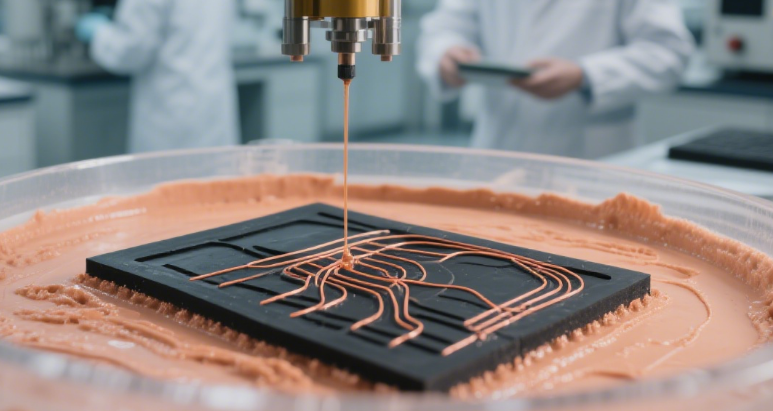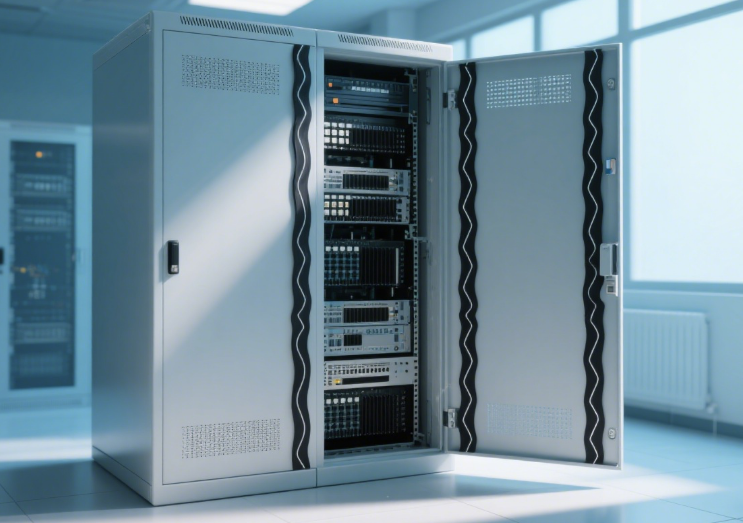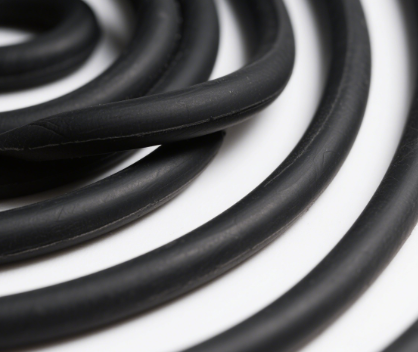The Application of On-site Molding Technology in the Manufacturing of Conductive Rubber
Abstract
This thesis deeply explores the application of on-site molding technology in the manufacturing of conductive rubber. It elaborates on the principles and characteristics of on-site molding technology in detail, analyzes its advantages over traditional manufacturing technologies in the manufacturing process of conductive rubber, introduces typical application scenarios, and discusses the current challenges and future development trends of this technology. The aim is to provide technical references and theoretical support for the conductive rubber manufacturing field and promote the technological innovation and development of this industry.
Keywords
On-site molding technology; Conductive rubber; Manufacturing process; Application; Development trend
- Introduction
As a functional material with both rubber elasticity and electrical conductivity, conductive rubber has a wide range of applications in many fields such as electronics, aerospace, automotive, and communication. From electromagnetic shielding of electronic devices and push-button switches to sealing and conductive connections of aerospace equipment, conductive rubber meets various special requirements with its unique properties. With the continuous improvement of the requirements for product performance, reliability, and integration in various industries, higher standards are also put forward for the manufacturing technology of conductive rubber. Traditional manufacturing technologies of conductive rubber gradually show limitations in production efficiency, product precision, and the molding of complex structures. As an emerging manufacturing technology, on-site molding technology, with its characteristics of flexibility, high efficiency, and precision, brings new opportunities and development directions for the manufacturing of conductive rubber. Studying the application of on-site molding technology in the manufacturing of conductive rubber is of great significance for improving the quality of conductive rubber products, expanding their application fields, and promoting the development of related industries.
- Principles and Characteristics of On-site Molding Technology
(I) Technical Principles
On-site molding technology is mainly based on the characteristics of liquid rubber materials. Through specific molding equipment and processes, the liquid rubber raw materials are mixed with conductive fillers on-site, and then directly molded and cured at the target position. This process usually involves chemical reactions or physical changes, promoting the transformation of liquid rubber into solid conductive rubber with specific shapes and properties. Common curing methods include thermal curing, room temperature curing, and light curing. Taking thermal curing as an example, during the molding process, a certain temperature is applied to the mixed rubber material to trigger the cross-linking reaction between rubber molecules, thus achieving the curing and molding of the material; light curing is to use light of a specific wavelength to irradiate the liquid rubber, stimulate the photoinitiator to generate free radicals, and promote the rapid polymerization reaction of rubber molecules to complete the molding process.
(II) Technical Characteristics
High flexibility: On-site molding technology can directly carry out molding operations on-site according to different application requirements and complex structural shapes without the need to make complex molds in advance. Whether for irregular curved surfaces, narrow spaces, or structures with special functional requirements, rapid and precise molding can be achieved, greatly improving the adaptability and design freedom of products.
High efficiency: Compared with the cumbersome processes such as mold making, raw material pretreatment, and multiple processing in traditional manufacturing technologies, on-site molding technology reduces intermediate links and shortens the production cycle. From the mixing of raw materials to molding and curing, the entire process can be completed in a relatively short time, improving production efficiency, especially suitable for scenarios such as small batch, customized product production, emergency repairs, and rapid prototype production.
Precision: With the help of advanced molding equipment and precise process control, on-site molding technology can achieve high-precision control of the size and shape of conductive rubber products. It can meet the strict requirements for product dimensional tolerances in fields such as electronics and aerospace, ensuring the consistency and reliability of products.
High material utilization rate: Since on-site molding technology is molded on demand, the amount of raw materials used can be precisely controlled according to actual needs, reducing material waste caused by processes such as mold making and cutting, improving the material utilization rate, and reducing production costs.
III. Advantages of On-site Molding Technology in the Manufacturing of Conductive Rubber
(I) Advantages in the Molding of Complex Structures
When traditional manufacturing technologies of conductive rubber deal with products with complex structures, they often need to make multiple sets of molds or use complex processing techniques, which is not only costly but also has a long production cycle, and it is difficult to ensure the molding precision. On the contrary, on-site molding technology can easily cope with the manufacturing of conductive rubber with complex structures with its flexible molding method. For example, in aerospace equipment, some conductive seals in special parts have irregular shapes and curved surface structures. The on-site molding technology can be directly molded on the surface of the equipment, perfectly fitting the complex structural shape, ensuring the sealing and conductive performance. At the same time, for some electronic devices with complex internal structures, the on-site molding technology can directly mold the conductive rubber components at the designated position during the equipment assembly process, achieving seamless connection and improving the overall performance and reliability of the equipment.
(II) Advantages in Rapid Response and Customized Production
In the rapidly developing market environment today, the product update cycle is accelerating, and the demand for customized conductive rubber products is increasing. On-site molding technology can quickly respond to customers’ personalized needs, and complete the molding and production of products in a short time according to different design requirements and usage scenarios. For some emergency orders or product repair needs, the on-site molding technology can quickly complete the manufacturing and replacement of conductive rubber components on-site, greatly shortening the product delivery cycle and repair time, and improving customer satisfaction and the market competitiveness of enterprises.
(III) Advantages in Performance Consistency
In the traditional manufacturing process, due to factors such as mold wear, differences in raw material batches, and fluctuations in processing techniques, it is easy to cause inconsistent performance of conductive rubber products. On the other hand, on-site molding technology uses precise raw material mixing and process control to ensure that the conductive rubber products formed each time maintain a high degree of consistency in electrical conductivity, mechanical properties, anti-aging properties, etc. Through the precise regulation of process parameters such as temperature, pressure, and curing time, as well as the effective control of the uniform dispersion of conductive fillers, the stability of product quality can be improved, meeting the strict requirements for product performance consistency in high-end application fields.
- Typical Application Scenarios of On-site Molding Technology in the Manufacturing of Conductive Rubber
(I) In the Field of Electronic Devices
Electromagnetic shielding: In electronic devices, to prevent the influence of electromagnetic interference on the performance of the device and signal transmission, electromagnetic shielding materials need to be used. On-site molded conductive rubber can be directly molded at the parts such as circuit boards and chassis according to the internal structure and shielding requirements of electronic devices, forming a seamless electromagnetic shielding layer. This method can effectively improve the shielding effect and reduce the shielding loopholes caused by the loose installation of traditional shielding materials. For example, in the equipment chassis of communication base stations, using on-site molded conductive rubber for electromagnetic shielding can effectively reduce the impact of electromagnetic radiation on the surrounding environment and the human body, ensuring the normal operation of the equipment.
Push-button switches: For some small and precise electronic devices such as mobile phones and tablets, the push-button switches have high requirements for the dimensional accuracy and tactile feel of conductive rubber. On-site molding technology can precisely control the shape and hardness of conductive rubber according to the design requirements of the buttons, and produce push-button switches with good elasticity and electrical conductivity. By adjusting the raw material formula and molding process, different tactile feels of the buttons can also be achieved, enhancing the user experience.
(II) In the Aerospace Field
Sealing and conductive connection: Aerospace equipment needs to withstand extreme environmental conditions such as temperature, pressure, and vibration during flight, and has extremely high requirements for the performance of sealing and conductive connection components. On-site molded conductive rubber can be directly molded at the joints of the aircraft fuselage, the edges of the cabin doors, the interfaces of electronic devices, etc., forming connection components with good sealing performance and conductive function. This method can ensure the sealing performance of the equipment in complex environments and the reliability of electrical connections, preventing the influence of the external environment on the internal system of the equipment and ensuring flight safety.
Antenna radome manufacturing: The antenna radome is an important component to protect the antenna from the external environment and needs to have good electromagnetic wave transmission performance and electrical conductivity. On-site molding technology can precisely control the distribution and thickness of conductive rubber during the manufacturing process of the antenna radome according to the shape and performance requirements of the antenna, achieving effective protection and performance optimization of the antenna. By adjusting the raw material formula and molding process, the antenna radome can have a certain electromagnetic protection ability while ensuring the electromagnetic wave transmittance, improving the working stability of the antenna system.
(III) In the Automotive Industry Field
Battery sealing and connection: With the rapid development of new energy vehicles, higher requirements are put forward for the safety and reliability of the battery system. On-site molded conductive rubber can be applied to the sealing and connection parts of automotive batteries, effectively preventing the leakage of battery electrolyte and the intrusion of external moisture and dust, and at the same time ensuring good conductive connection between the various components of the battery. Through on-site molding technology, suitable sealing and connection components can be customized according to the different structures and sizes of the battery, improving the overall performance and service life of the battery system.
Protection of in-vehicle electronic devices: There are many in-vehicle electronic devices in automobiles, such as in-vehicle navigation, audio systems, sensors, etc., which need to work normally in complex electromagnetic environments and vibration environments. On-site molded conductive rubber can be molded at the shells, interfaces, etc. of in-vehicle electronic devices, providing electromagnetic shielding and buffering and shock absorption functions, protecting the electronic devices from external interference and mechanical damage, and improving the reliability and stability of the devices.
- Challenges Faced by On-site Molding Technology in the Manufacturing of Conductive Rubber
(I) Challenges in Raw Materials and Process Control
Raw material compatibility: In on-site molding technology, the compatibility between liquid rubber raw materials and conductive fillers has an important impact on product performance. During the mixing process of different types of rubber and conductive fillers, problems such as uneven dispersion and poor interfacial bonding force may occur, resulting in unstable electrical conductivity and decreased mechanical properties. For example, the surface properties of some conductive fillers are quite different from the rubber matrix, making it difficult to uniformly disperse in the rubber, affecting the formation of conductive pathways and the overall performance of the product.
Sensitivity of process parameters: Process parameters such as temperature, pressure, and curing time in the on-site molding process have a significant impact on the molding quality and performance of conductive rubber. Slight fluctuations in parameters may lead to large differences in product performance. For example, during the thermal curing process, if the temperature control is inaccurate, it may lead to incomplete or excessive cross-linking of the rubber, affecting the elasticity and electrical conductivity of the product; during the light curing process, improper control of the light intensity and time will lead to incomplete curing or deterioration of material properties. Therefore, it is necessary to precisely control the process parameters and establish a complete process parameter monitoring and adjustment system.
(II) Challenges in Equipment and Cost
Research and development of special equipment: On-site molding technology requires special molding equipment, including raw material mixing equipment, molding molds, curing equipment, etc. At present, there are relatively few types of equipment suitable for on-site molding of conductive rubber, and the functions of some equipment are not perfect enough, making it difficult to meet the needs of different application scenarios and complex processes. The research and development of high-performance and multi-functional special equipment requires a large amount of capital and technical force, which is a great challenge for enterprises.
Cost control: Although on-site molding technology has advantages in material utilization, due to the high research and development and procurement costs of special equipment, as well as the demand for high-quality operators, the overall production cost increases. In addition, some high-performance liquid rubber raw materials and conductive fillers are expensive, further increasing the production cost. How to effectively control the cost while ensuring product quality and improve economic benefits is an important issue in promoting on-site molding technology.
(III) Challenges in Quality Inspection and Standard System
Difficulties in quality inspection: There are certain difficulties in the quality inspection of on-site molded conductive rubber products. Since the products are molded on-site, the inspection of their internal structure and performance cannot use conventional inspection methods like traditional manufactured products. For example, for on-site molded conductive rubber seals, it is difficult to directly detect the distribution of internal conductive pathways and sealing performance. It is necessary to develop new detection technologies and methods to ensure that the product quality meets the requirements.
Incomplete standard system: At present, the quality standards and inspection specifications for on-site molded conductive rubber products are not perfect. Different production processes and quality control methods adopted by different enterprises lead to uneven product quality and a lack of unified evaluation standards. This not only affects the market promotion and application of products but also hinders the standardized development of the industry. Establishing a complete quality standard and inspection system is the key to promoting the healthy development of on-site molding technology in the field of conductive rubber manufacturing.
- Development Trends of On-site Molding Technology in the Manufacturing of Conductive Rubber
(I) Innovation and Optimization of Raw Materials
In the future, new types of liquid rubber raw materials and conductive fillers will continue to be developed to improve the compatibility between raw materials and product performance. For example, developing rubber materials with special functional groups to enhance the interfacial bonding force with conductive fillers; studying new types of nanoscale conductive fillers to improve the dispersibility and electrical conductivity of the fillers, thus preparing conductive rubber with more excellent performance. At the same time, modify and optimize existing raw materials to reduce raw material costs and improve the processability and stability of raw materials.
(II) Intelligence and Automation of Equipment
With the development of intelligent manufacturing technology, on-site molding equipment will develop towards intelligence and automation. By introducing sensors, control systems, and artificial intelligence technology, real-time monitoring and automatic adjustment of process parameters during the molding process can be achieved, improving the operation precision and stability of the equipment. At the same time, develop more automated molding equipment, reduce manual operation, and improve production efficiency and product quality consistency. For example, research and develop integrated equipment with functions such as automatic feeding, mixing, molding, and curing to achieve fully automated production of conductive rubber manufacturing.
(III) Process Optimization and Integration
Further optimize the on-site molding process, explore the integrated application of multiple molding processes to improve product quality and production efficiency. For example, combine thermal curing and light curing processes to give full play to the advantages of the two curing methods, shorten the curing time, and improve product performance. At the same time, study the optimized combination of process parameters, establish a more complete process model and control system, and achieve precise control of the molding process. In addition, strengthen the integration with other manufacturing technologies, such as combining with 3D printing technology to achieve rapid molding and personalized customization of conductive rubber products.
(IV) Perfection of Quality Inspection and Standard System
Increase the research efforts on the quality inspection technology of on-site molded conductive rubber products, develop new non-destructive testing technologies and online testing methods, and achieve rapid and accurate detection of the internal structure and performance of products. At the same time, promote the formulation and improvement of industry standards, establish unified quality standards and inspection specifications, standardize the production behavior of enterprises, improve product quality and market competitiveness, and promote the standardized development of on-site molding technology in the field of conductive rubber manufacturing.
VII. Conclusion
With its unique principles and characteristics, on-site molding technology shows significant advantages and broad application prospects in the manufacturing of conductive rubber. In many fields such as electronic devices, aerospace, and the automotive industry, on-site molding technology provides new solutions for the manufacturing of conductive rubber products, meeting the requirements of different industries for product performance, precision, and customization. However, this technology also faces challenges in raw materials and process control, equipment and cost, quality inspection and standard system, etc. With the continuous progress of science and technology, through raw material innovation, equipment intelligence, process optimization, and the improvement of quality inspection and standard systems, on-site molding technology is expected to be more widely applied and developed in the field of conductive rubber manufacturing, promoting the conductive rubber manufacturing industry to move towards a higher level and providing strong support for the development of related industries.


















